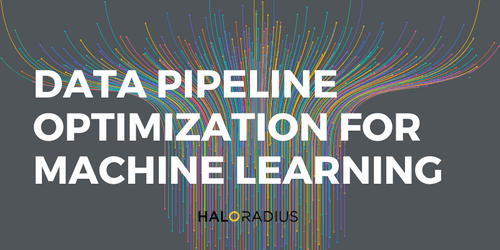Optimizing data pipelines is crucial for successful machine learning (ML) projects, especially in enterprise environments where inefficiencies can significantly drive up costs and hinder performance.
Let’s walk through the key aspects of optimizing data pipelines, focusing on data ingestion, model training, and flow optimization. By implementing these strategies, you can streamline your ML workflows, reduce costs, and enhance overall performance.
The Cost of Data Pipeline Inefficiency in ML
The success of ML models hinges not just on algorithms but on the effectiveness of the data pipelines that feed them. Inefficiencies in data handling can lead to increased costs, extended time-to-market, and suboptimal model performance. In a landscape where speed and efficiency are paramount, optimizing your data pipelines is not just a best practice—it’s a necessity.
Understanding the critical elements of data pipelines, from ingestion to training and flow, allows organizations to build ML systems that are both cost-effective and scalable. Let’s explore the essential strategies to enhance your data pipelines.
Understanding the Impact of Data Ingestion
Data ingestion is the first step in the ML pipeline, involving the acquisition, cleansing, and transformation of raw data into a format suitable for model training. The efficiency of this stage directly impacts the cost and performance of the entire ML system.
Identifying Cost Drivers in Data Ingestion
Data ingestion inefficiencies often manifest as increased processing times, higher storage costs, and excessive consumption of computing resources. Key cost drivers include:
- Data Quality Issues: Poor-quality data requires extensive cleansing and transformation, which consumes additional resources. Addressing data quality issues early in the pipeline can lead to significant cost reductions later on.
- Inefficient ETL Processes: Extraction, transformation, and loading (ETL) operations that are not optimized can bottleneck the entire pipeline. Leveraging parallel processing, distributed computing, and data segmentation can enhance ETL efficiency, reducing costs and improving throughput.
Optimizing data ingestion involves streamlining these processes to reduce waste and improve data handling efficiency.
Optimizing Model Training for Cost-Effectiveness
Model training is one of the most resource-intensive stages of the ML pipeline. It involves large-scale data processing and computationally expensive algorithms, making it a significant contributor to overall project costs.
Techniques to Minimize Computational Resources During Training
- Transfer Learning: This approach leverages pre-trained models to reduce the training required for new tasks, cutting down on computational costs.
- Model Distillation: Training smaller models to mimic larger ones can achieve a balance between model accuracy and resource efficiency, reducing the computational footprint.
- Parameter Pruning: By identifying and removing unnecessary parameters, you can decrease the model’s complexity and resource requirements without sacrificing performance.
These techniques help reduce the time and computational resources needed for training, resulting in more cost-effective ML deployments.
Implementing Early Stopping and Other Cost-Saving Strategies:
Early stopping, which halts training when a model’s performance on validation data plateaus, is a simple yet effective way to save on resources. Additionally, using hardware accelerators like GPUs and TPUs can significantly speed up training times, making them an essential part of an optimized training strategy. Cloud-based platforms like Google Cloud and Amazon Web Services offer scalable solutions for distributed training, allowing you to adjust resources dynamically based on demand.
Data Pipeline Flow Optimization Tips
Optimizing the flow of data through the pipeline is critical for achieving overall efficiency. This involves strategies such as data compression, batching, and effective scheduling.
Leveraging Data Compression and Batching:
- Data Compression: Techniques like gzip or Snappy reduce storage needs and speed up data transfer, which is crucial when dealing with large datasets.
- Batching: Processing data in larger chunks rather than individual records reduces processing overhead and makes better use of computing resources. However, batching might not suit real-time data needs, where micro-batching or streaming can strike a balance between real-time processing and efficiency.
Implementing Scheduling Strategies to Optimize Resource Utilization
Effective scheduling ensures that resources are utilized efficiently without bottlenecks. Priority-based job queues can help ensure that critical tasks are processed first, while dynamic resource allocation allows for scaling resources based on real-time needs.
By continuously monitoring and analyzing the performance of your data pipeline, you can make iterative improvements to maintain efficiency. Tools like Prometheus and Grafana are invaluable for tracking key metrics and identifying areas for enhancement.
Conclusion: Building Cost-Effective ML with a Streamlined Data Pipeline
Optimizing data pipelines is not just about improving efficiency—it’s about enabling your ML projects to scale and succeed in production environments. By focusing on data quality, efficient ETL processes, and cost-effective training strategies, you can reduce operational costs and improve the overall performance of your ML systems.
Key takeaways to recall:
- Address Data Quality Early: Prevent costly downstream impacts by ensuring high-quality data from the outset.
- Optimize Training Processes: Use techniques like transfer learning and model distillation to reduce resource usage and speed up training.
- Streamline Data Flow: Employ data compression, batching, and intelligent scheduling to maximize resource utilization and reduce latency.
As ML continues to evolve, staying ahead with optimized data pipelines will be critical for maintaining competitive advantage. Begin optimizing your data pipelines today to unlock new efficiencies and drive greater innovation in your AI initiatives. By leveraging the strategies outlined here, you can build a solid foundation for cost-effective, scalable, and high-performing ML projects.
For further exploration of best practices in ML pipelines, consider resourc

